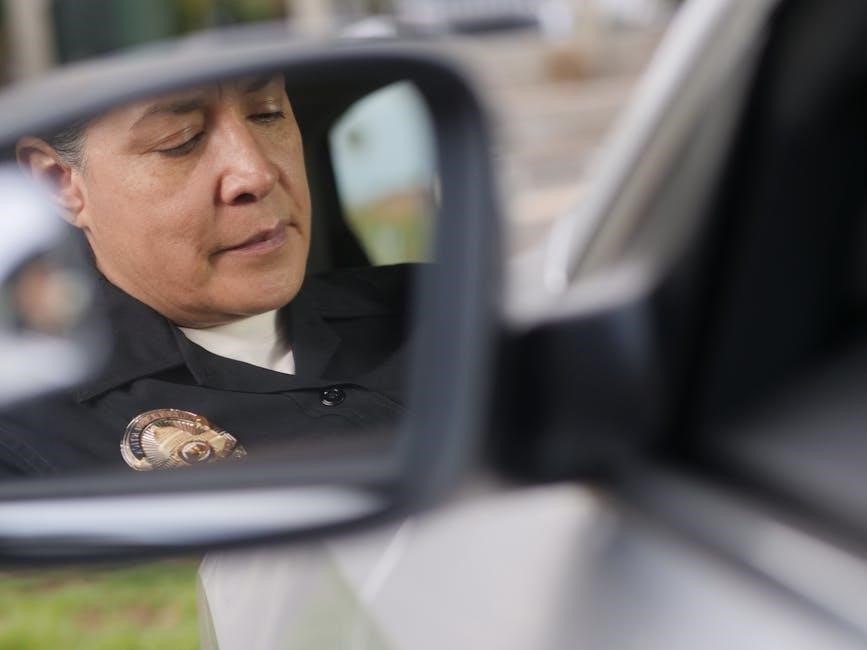The Brownie Cybersecurity Badges empower young girls to understand online safety, privacy, and digital responsibility. The program offers three badges: Basics, Safeguards, and Investigator, each with unique requirements and activities designed to build essential cybersecurity skills. A free PDF guide provides detailed steps, fun facts, and background information, helping girls navigate the digital world confidently while fostering curiosity and leadership in STEM fields.

Overview of the Three Cybersecurity Badges
The Brownie Cybersecurity program offers three distinct badges: Cybersecurity Basics, Cybersecurity Safeguards, and Cybersecurity Investigator. Each badge is designed to build essential skills in online safety, privacy, and digital responsibility. The Cybersecurity Basics badge introduces girls to the fundamentals of technology and security. The Cybersecurity Safeguards badge focuses on protecting personal information and recognizing online threats. The Cybersecurity Investigator badge encourages problem-solving through coding and analyzing digital footprints. A comprehensive PDF guide outlines the requirements, activities, and resources needed to earn each badge, making it easy for troop leaders to guide their girls through the program.
Importance of Cybersecurity Education for Young Girls
Cybersecurity education is crucial for young girls, equipping them with vital skills to navigate the digital world safely. The Brownie Cybersecurity Badges foster awareness about online safety, privacy, and digital responsibility, empowering girls to protect themselves and their information. These badges also encourage interest in STEM careers, promoting gender diversity in the cybersecurity field. By learning to recognize threats and apply safety measures, girls develop confidence and resilience in their online interactions, setting a foundation for lifelong digital literacy and leadership.
Cybersecurity Basics Badge
The Cybersecurity Basics Badge introduces girls to fundamental concepts, teaching them to recognize technology’s role in daily life and how to apply basic online safety measures effectively.
Step 1: Understanding Technology Usage
Step 1 focuses on recognizing how technology is integrated into daily life. Girls explore how they use devices like computers, phones, and tablets for tasks like gaming, homework, and communication. The activity encourages identifying ways technology surrounds them, from home appliances to public systems like traffic lights and elevators. By understanding their interaction with technology, girls begin to grasp the importance of cybersecurity in protecting their digital activities and personal information. This foundational step sets the stage for learning essential safety measures in the digital world, fostering awareness and curiosity about technology’s role in their lives.
Step 2: Discovering What Technology Can Do
Step 2 delves into exploring the vast capabilities of technology. Girls learn how devices like smartphones and computers can perform tasks beyond entertainment, such as managing schedules, accessing information, and connecting with others globally. The activity highlights how technology powers everyday systems like traffic lights, medical devices, and security systems. By understanding the breadth of technology’s role, girls gain insight into its importance and the need to protect it. This step fosters curiosity and appreciation for how technology shapes their lives, laying the groundwork for learning cybersecurity practices to safeguard these essential tools and systems.
Step 3: Creating Layers of Security
In Step 3, girls learn the importance of multiple layers of security to protect technology and personal information. Just as wrapping an egg in layers of materials prevents it from breaking, combining strategies like strong passwords, antivirus software, and firewalls creates robust protection. Activities include identifying computer parts and understanding their roles in security. Girls also engage in a word-scramble exercise to learn key terms like “CPU” and “webcam.” By grasping these concepts, they develop practical skills to safeguard their devices and data, fostering a mindset of proactive cybersecurity in their daily lives and future endeavors.

Step 4: Applying Real-Life Safety Rules Online
In this step, girls learn to apply real-life safety rules to online interactions. Just as they stay close to parents in public or look both ways before crossing the street, they discover how to stay safe online. Activities focus on translating everyday safety habits into digital practices, such as avoiding strangers online and following family rules for internet use. By understanding these parallels, girls develop essential skills to protect themselves and their information, ensuring a safer and more secure digital experience. This step emphasizes the importance of vigilance and responsibility in both the physical and virtual worlds.
Step 5: How Messages Travel on the Internet
In this step, girls learn how messages travel online. When sending information like emails or photos, it’s broken into small pieces called packets. Each packet gets an address to ensure it reaches the right destination. These packets travel through routers and servers, reassembling at the recipient’s device. This process is similar to shipping a large object in separate boxes, making it efficient and secure; Understanding how data moves online helps girls grasp the basics of cybersecurity and the importance of protecting digital communications. This knowledge builds a foundation for safer online interactions and responsible technology use.
Cybersecurity Safeguards Badge
The Cybersecurity Safeguards Badge focuses on protecting personal information, recognizing online scams, and understanding digital footprints. Girls learn to safeguard data and make informed online decisions.
Protecting Personal Information Online
The Cybersecurity Safeguards Badge teaches girls to identify and protect personal information, understanding its importance in maintaining privacy and security. Activities include matching games to recognize private data, such as addresses or phone numbers, and discussions on the risks of sharing sensitive information online. Girls learn to create strong passwords and use privacy settings on devices. The badge emphasizes the consequences of oversharing and how to apply real-life safety rules to online interactions, ensuring they can safeguard their personal details effectively in a digital world.
Recognizing and Avoiding Online Scams
The Cybersecurity Safeguards Badge helps girls learn to identify and avoid online scams, empowering them to stay safe in the digital world. Activities include identifying scam characteristics, such as too-good-to-be-true offers or suspicious links, and understanding phishing tactics. Girls participate in role-playing exercises to practice responding to fake emails or calls. They also create posters to share tips on avoiding scams, fostering awareness and confidence in protecting themselves and others online. This step emphasizes the importance of privacy settings and seeking guidance from trusted adults when encountering suspicious content.
Understanding Digital Footprints
Understanding digital footprints is a key part of the Cybersecurity Safeguards Badge. Girls learn how their online actions leave behind traces, shaping their digital identity. Activities include creating avatars to represent themselves online while protecting personal details. They explore how social media posts, comments, and shared photos contribute to their footprint. Girls also discover how to manage their digital presence by deleting old accounts and using privacy settings. This step emphasizes the importance of being mindful of online behavior and making informed decisions to protect their reputation and security in the digital world.

Cybersecurity Investigator Badge

Earn this badge by solving cyber mysteries! Crack codes, investigate real vs. fake photos, and explore digital footprints. Girls become detectives, learning cybersecurity through fun, hands-on activities.
Cracking Codes to Solve Problems
Girls learn to crack codes and solve problems using encryption and decryption methods. They explore how codes protect information and practice decoding messages. Historical ciphers, like Caesar ciphers, introduce basic cryptography. Modern encryption methods show how data stays secure online. Activities include creating secret messages and deciphering puzzles. This step fosters problem-solving skills and curiosity in cybersecurity. By mastering these techniques, girls understand how codes safeguard digital information, preparing them for real-world applications in protecting personal and sensitive data. Hands-on exercises make learning fun and engaging, while teamwork enhances collaboration and critical thinking.
Investigating Real and Fake Photos
Girls learn to identify real and fake photos, understanding how images can be manipulated. They analyze clues like inconsistencies in lighting, shadows, or pixelation. Activities include comparing original and edited images, exploring photo-editing tools, and discussing ethical implications. This step encourages critical thinking about digital content and its authenticity. By mastering these skills, girls become more discerning consumers of online information, better equipped to spot misinformation and protect themselves from deception. Hands-on exercises make learning engaging and relevant to everyday digital experiences.
Exploring Digital Footprints
Earning this step, girls learn about digital footprints, the trail of data left behind by online activities. They discover how posts, comments, and interactions shape their online presence. Activities include creating a positive digital footprint and understanding its impact on reputation and privacy. Girls also explore how to manage their footprint responsibly. This step emphasizes the importance of mindful online behavior and the long-term effects of digital actions. By completing this, they gain skills to navigate the internet thoughtfully and protect their privacy in a connected world.

Accessing the Badge Requirements PDF
The Brownie Cybersecurity Badge Requirements PDF is available for free through the Volunteer Toolkit or your local Girl Scout council. It provides badge requirements, background information, and fun facts for all three badges, serving as a valuable resource for troop leaders and girls alike.
Where to Find the PDF
The Brownie Cybersecurity Badge Requirements PDF is easily accessible through the Volunteer Toolkit (VTK) or by contacting your local Girl Scout council. This free resource provides detailed requirements, activities, and background information for all three badges. While the PDF itself is complimentary, a corresponding booklet is available for purchase, offering engaging content and fun facts to enhance the learning experience. Troop leaders can also find comprehensive meeting plans and activity instructions within the VTK, ensuring a well-rounded and educational experience for participants. This streamlined access ensures that girls and leaders have everything needed to succeed in earning their cybersecurity badges.
What to Expect in the Badge Booklet
The Brownie Cybersecurity Badge Booklet is a comprehensive guide designed to engage young girls in learning about online safety and digital responsibility. It includes detailed requirements for each of the three badges—Basics, Safeguards, and Investigator—along with fun facts and background information to make the learning process enjoyable. The booklet also features activities that encourage hands-on participation, such as solving problems through coding, identifying real and fake photos, and understanding digital footprints. Additionally, it provides a supply list and a Leader’s Guide, offering troop leaders the tools to create an interactive and educational experience for their girls.
